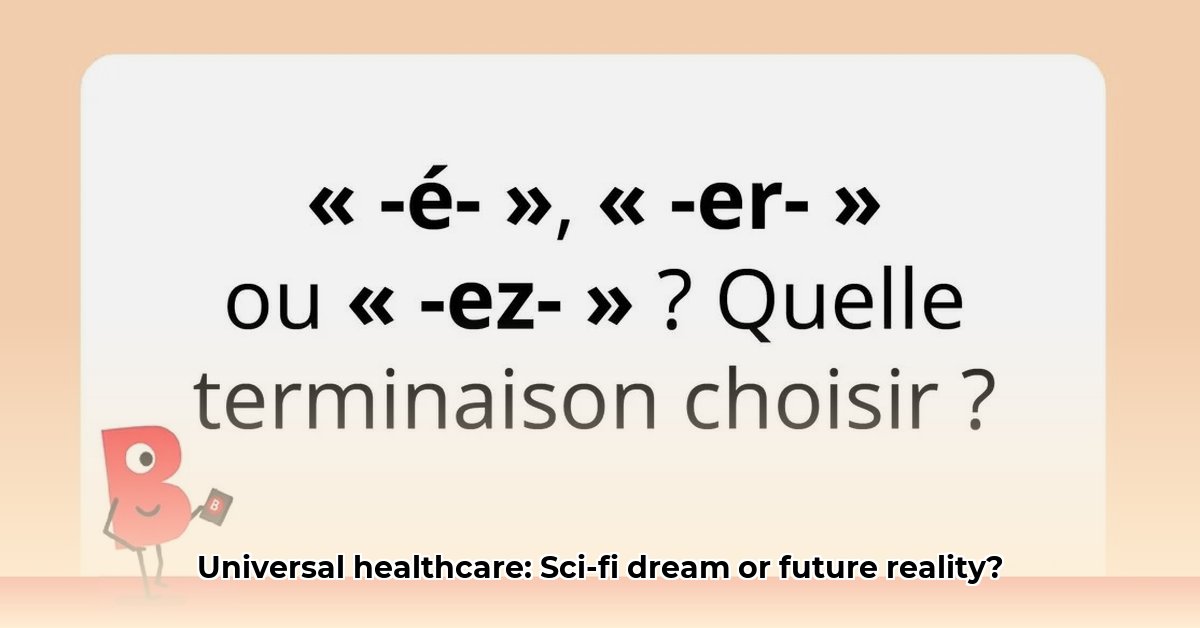So, you’ve got this graphic novel, ET-ER, about an alien hospital where everyone – humans and space slugs alike – gets treated. It’s a fun, wild ride, but it also got me thinking about how we could actually make healthcare better here on Earth. For more information on existing healthcare coverage options, check out Medicaid coverage. This isn’t your typical comic book review; we’re going to dissect ET-ER‘s take on universal healthcare, see what works (and what doesn’t), and figure out how its ideas could help us fix our own healthcare systems. Think of it as a blend of comic book critique and brainstorming session for a better future – because who doesn’t want that? We’ll explore the good, the bad, and the downright bizarre, all while keeping things clear and easy to understand, no medical jargon required (unless it’s alien medical jargon, which is always fun).
ET-ER: A Sci-Fi Vision of Universal Healthcare
ET-ER, the graphic novel, isn’t your typical alien invasion story. Instead, it throws us headfirst into an intergalactic emergency room, a place where doctors treat patients from all corners of the cosmos – think furry creatures with three eyes, beings made of pure energy, and everything in between. It’s a wild ride, but the real story isn’t about the wacky alien ailments (although those are pretty fun!). It’s about a fundamental question: what would a truly fair and accessible healthcare system look like?
The genius of ET-ER is its clever way of showing us, not just telling us. We meet Dr. Chen early on, struggling with the limitations of a traditional healthcare system— long wait times, confusing bureaucracy, and unequal access based on who you are or where you’re from. This is our reality, reflected in a familiar mirror, but then… bam! We’re transported to the ET-ER. This place is different. It’s smooth, efficient, and importantly, welcoming to everyone, regardless of species or background. It’s like a “before and after” photo showcasing the power of a good healthcare system.
This intergalactic clinic embraces a diverse team— alien doctors, human nurses, robotic assistants, you name it. They all work together seamlessly, demonstrating that tackling tough medical cases requires different skills and perspectives. Think of it like baking a cake: you need the baker, the ingredient supplier, even the person who makes sure the oven’s working properly. In ET-ER, this teamwork is not just shown but stressed as essential to success. It’s a pretty powerful metaphor for how we should approach healthcare on Earth, too.
What ET-ER Gets Right and Where It Falls Short: A Balanced Look
ET-ER absolutely nails the concept of universal access. The comic perfectly captures the ideal of everyone receiving care, no questions asked. It’s a strong visual statement, grabbing your attention right away and making you think. But, the graphic novel deliberately keeps the medical details simple. The story focuses more on the ethical and philosophical sides, rather than getting into the nitty-gritty of alien anatomy or medical procedures. That’s fine. It makes the story accessible to everyone, not just doctors or science buffs. While it might not satisfy medical professionals craving technical accuracy, it’s perfect for sparking conversations about healthcare ethics.
Beyond the Panels: Lessons We Can Take Away
So, what can we learn from this out-of-this-world hospital? Honestly, quite a bit. The true strength of ET-ER is its ability to get us thinking and talking about improving our own healthcare systems. The graphic novel presents a compelling vision, and inspires us to ask ourselves some tough questions.
Here’s a breakdown of how different groups can use ET-ER as a launchpad for positive change:
| Stakeholder Group | Short-Term Goals (0-1 year) | Long-Term Goals (3-5 years) |
|---|---|---|
| Healthcare Providers | Focus on improving teamwork and communication across medical disciplines; Explore new collaborative models. | Develop more adaptable approaches that cater to many different patient needs and backgrounds; Prioritize patient-centric care. |
| Policy Makers | Analyze how resources are currently shared; Investigate ways to make care more accessible to everyone. | Invest in technology that improves communication between healthcare facilities; Prioritize funding for equitable access. |
| Educators | Integrate sci-fi stories like ET-ER into medical ethics classes; Encourage discussions on ethical dilemmas. | Develop training programs that promote cultural competency in healthcare; Emphasize inclusive and equitable approaches. |
| Technology Developers | Create telehealth solutions for people in underserved areas; Develop tools to help with remote care. | Explore the use of AI in diagnostics to help deal with a wider range of conditions; Make technology more user-friendly. |
ET-ER doesn’t offer concrete solutions, but it does give us a fantastic starting point. The graphic novel presents a powerful vision of a more inclusive and equitable healthcare system. It challenges us to consider: How do we bring that same spirit of inclusivity and collaboration into our own world? How can we ensure everyone has access to the care they need, regardless of their circumstances? It’s a thought-provoking read that compels us to think bigger, think better, and most importantly, think about how we can all work together to create a healthier future for everyone.
How to Apply ET-ER’s Intergalactic Healthcare Model to Improve Earth’s Healthcare Systems
Let’s face it: Earth’s healthcare system is a mess. Long wait times, exorbitant costs, and patchy access plague many parts of the world. Could a fictional graphic novel hold the key to fixing it? Perhaps surprisingly, ET-ER‘s depiction of intergalactic healthcare offers some interesting insights.
ET-ER’s Vision: Universal Access and Holistic Care
ET-ER, while a work of science fiction, proposes a healthcare model built on universal access and an incredibly holistic approach. Imagine a system where everyone, regardless of their planet of origin, receives comprehensive care. This isn’t just about treating illnesses; it’s about preventative medicine, mental health integration, and a focus on overall well-being. Sounds utopian, right?
But how realistic is this? The graphic novel, while lacking medical specifics, emphasizes several key features ripe for earthly application:
-
Interdisciplinary Collaboration: ET-ER showcases a team approach, bringing together diverse specialists. Think doctors, therapists, even alien biologists! This mirrors the growing movement toward integrated care on Earth, bringing together various healthcare professionals to provide coordinated care.
-
Tech Integration: The novel hints at advanced technology facilitating diagnosis and treatment. Although not detailing specific technologies, it presents a compelling argument for embracing technology – from telemedicine (remote healthcare via technology) to AI-powered (artificial intelligence) diagnostics – to enhance access and efficiency.
-
Data-Driven Decisions: ET-ER suggests a system using vast data sets to predict and prevent health crises. This aligns with the current push towards preventative medicine and public health initiatives enabled by data analytics (analyzing large data sets to find trends).
Translating ET-ER to Earth: Practical Steps
How to apply ET-ER’s intergalactic healthcare model to improve earth’s healthcare systems isn’t about cloning alien technology. It’s about adapting successful principles. Here’s a roadmap:
-
Prioritize Integrated Care: Build on already-existing models of integrated care by actively fostering collaboration between various healthcare providers. This requires investment in training and infrastructure. Consider implementing shared electronic health record systems to facilitate seamless information exchange between specialists.
-
Embrace Technology Strategically: Invest in modern technologies like telemedicine, AI-powered diagnostic tools, and electronic health records. This isn’t about replacing doctors; it’s about empowering them. For instance, AI can analyze medical images faster and more accurately, helping doctors make quicker decisions.
-
Harness the Power of Data: Improve data collection and analysis to understand population health trends, predict outbreaks, and allocate resources more effectively. This will require robust data privacy measures. Data dashboards can be created to visually represent key health indicators and inform policy decisions.
-
Focus on Preventative Care: Shift focus from reactive treatment to proactive prevention. Increase funding for public health initiatives focusing on education, early detection and lifestyle interventions. Implement community-based programs promoting healthy eating and exercise habits.
-
Promote Universal Access: Strive to create systems ensuring healthcare access for all, regardless of socioeconomic status or geographic location. This necessitates policies that address affordability and availability. Explore options like expanding Medicaid or implementing a single-payer system.
Challenges and Considerations
While ET-ER presents an aspirational model, translating it to our reality poses significant challenges:
- Funding: Universal healthcare requires substantial investment. Consider value-based care models that incentivize quality over quantity.
- Infrastructure: Building the necessary technological and physical infrastructure is expensive and requires collaboration. Public-private partnerships can help bridge the funding gap.
- Regulatory hurdles: Integrating technology and ensuring patient data privacy will necessitate new regulations and guidelines. Implement strict data security protocols and adhere to HIPAA regulations.
The Bottom Line
ET-ER’s intergalactic healthcare system isn’t a blueprint for immediate copy-pasting. It does, however, offer valuable inspiration. By focusing on integrated care, technological innovation, data-driven decisions, preventative measures, and universal access, we move closer
- Bulking Lunch Recipes that Make Muscle Gain Delicious - November 12, 2025
- Simple Asian Meal Prep Recipes to Spice Up Your Week - November 11, 2025
- Simple Asian Meal Prep Ideas For Healthy And Flavorful Weekday Meals - November 10, 2025










